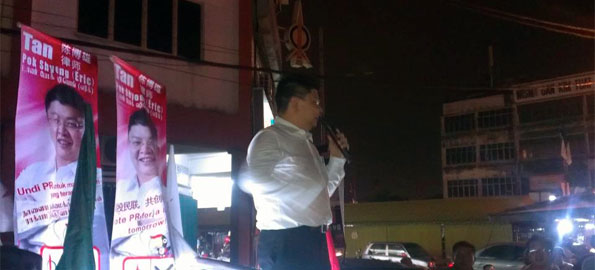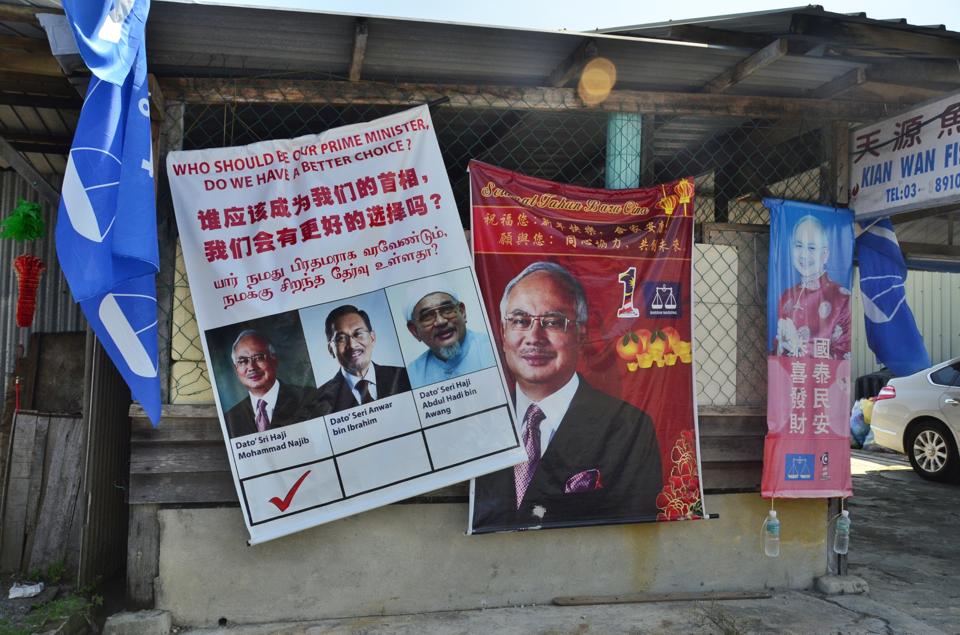COMMENT In the past week, two Malay newspapers Utusan Malaysia and Kosmo! chose to have as their headlines controversial statements that could be considered incendiary in reference to the Chinese having rejected Barisan Nasional in favour of the opposition Pakatan Rakyat, following the results of the 13th general elections held almost a week ago.
 Both former and current Prime Ministers Dr Mahathir Mohamed and Najib Abdul Razak (right) have said as much, creating the public perception that this election marked out the stark difference in voting patterns between the Malays and Chinese, especially in the latter’s reference to a ‘Chinese Tsunami’.
Both former and current Prime Ministers Dr Mahathir Mohamed and Najib Abdul Razak (right) have said as much, creating the public perception that this election marked out the stark difference in voting patterns between the Malays and Chinese, especially in the latter’s reference to a ‘Chinese Tsunami’.
Malaysians have to caution against this ethnic positioning as an easy blame game, for several reasons.
First, it is more accurate to state that the results saw a split between urban and rural voters, hence a spatial and class, rather than an ethnic, divide.
 Pakatan strengthened its incumbent position by winning two-third majorities in Selangor and Penang, the two most industrialised and urban states, which together contribute to the almost 60 percent of the country’s GDP.
Pakatan strengthened its incumbent position by winning two-third majorities in Selangor and Penang, the two most industrialised and urban states, which together contribute to the almost 60 percent of the country’s GDP.
In Selangor, the only parliamentary seats won by Barisan were in the more rural or semi-urban areas such as Sabak Bernam, Sungai Besar and Tanjong Karang.
In Seremban, DAP candidate Anthony Loke would not have won with more than a 12,000 majority (and a 16,501 swing) had it not been for Malay support, where Malays constitute 44 percent of the seat’s population.
Flawed argument gets nailed
The argument that opposition gains were only due to Chinese swing is also not fully accurate, since Malay-majority seats such as Kuala Terengganu (89 percent Malay, 10 percent Chinese) were wrested by Pakatan with a 10,785 majority (and a 11,413 swing). Both are urban seats.
It is ,therefore, too simplistic to attribute the opposition’s gains to racial polarisation, since one must equally examine class and geographical differences.
Second, the allegations of electoral fraud make it difficult for accurate analysis to take place.
Pakatan has accused the electoral system of being rigged through a number of ways, such as providing identity cards for foreigners to vote, flying them into the peninsula en masse from East Malaysia, and Malaysians having their names either removed from the voter roll or registered without their knowledge, ‘indelible ink’ that was very easily removed, and vote-buying, among other discrepancies.
If the fraud is indeed as widespread as alleged, then this raises serious concerns as to the legitimacy of the election results, which has a direct effect on our reading of voter sentiment.
Out of the 24 parliamentary seats with a majority of less than 1,500, 17 of them were eventually won by Barisan – including Bentong and Kuala Selangor, where initial results saw the Pakatan candidates leading.
In many cases, the number of spoilt votes exceeded the majority, and the majority was less than 4 percent of the total number of votes, the latter of which would have required a recount although this was denied in Kuala Selangor.
Game of statistics stripped
Barisan is now the federal government because it bagged 133 seats out of the 222 in total, giving it a majority of 22 seats.
However, a series of questions must be asked: Could the Barisan win at the federal level be attributed to the wins in these marginal seats, some of which had their results changed after the recounts?
 If so, should the Election Commission not investigate the alleged fraud cases that could have affected the outcomes of the razor-thin wins of such seats, which in turn would have led to a very different result?
If so, should the Election Commission not investigate the alleged fraud cases that could have affected the outcomes of the razor-thin wins of such seats, which in turn would have led to a very different result?
Finally, statistics are emerging that demonstrate the effects of malapportionment on the election results. Pakatan’s 89 seats had an average of 63,191 votes cast, compared with Barisan’s 133 seats which had an average of 39,381.
Simply put, Pakatan won in the seats with larger constituencies, while Barisan won in the smaller ones.
This explains the Barisan win, despite Pakatan having won the popular vote with 51.4 percent of the population’s support and Barisan with 48.6 percent.
Moving forward, both political coalitions – together with civil society – will have to reflect deeply upon what actions are needed to address these issues, as well as their mid to long-term implications.
Time to look at naked truth
There is an urgent need for Pakatan to craft messages that better target the low-income, rural and Malay voters, assuring them that their lifelines would not be cut off without Umno around.
Barisan has to take a good look at its coalition model, since its component parties MCA and Gerakan are effectively depleted.
It will also have to examine the reasons for which urban, middle-class voters rejected their offerings so resoundingly.
In order for the alleged electoral fraud to be taken seriously, cases have to be systematically compiled and recorded.
Bersih 2.0 has stated it would organise a People’s Tribunal to this end, while PKR has appointed newly elected Member of Parliament Rafizi Ramli for its compilation purposes.
This will be in addition to the election petitions expected to be filed by Pakatan parties in 20 constituencies or so, in which the winning margin was less than 5 percent.
It is hoped that the lawsuits, which must be filed within 21 days after the results are gazetted, would be an effective recourse sought by Pakatan in seeking justice for what it considers an unfair elections.
Even if these efforts, accompanied by hard evidence, fail to ultimately impact upon the election results, they would still be crucial for the court of public opinion in the coming months, for historical record as well as valuable lessons learnt in order to better prepare for the 14th general election.
Why GE13 should be toasted
Finally, it is clear that without genuine electoral reform, even an election which is the most fundamental form of democracy would not be conducted fairly, nor its citizens’ votes respected.
In a system where parliamentary seats are not fairly weighted nor apportioned, the party with minority support emerges the victor.
This is an unfortunate consequence of the way constituencies are demarcated at present, which can only be amended with a two-third majority support in Parliament.
Before political analysts deduce that this was an election that divided Malaysia racially, one must be cognisant that if not for these irregularities, a very different result would have emerged.
Coming to a conclusion based on the election results at merely face value would not be entirely accurate.
If anything, it must be pointed out that young urban-dwellers voted across ethnic lines for the opposition against a corrupt regime, a trend that will only continue given that urbanisation is expected to exceed 70 percent by 2020.
It is this that should instead be celebrated and not conveniently ignored, in the desperate need to explain the worst election performance in Barisan’s history as entirely due to the racial divide.
In the journey towards a more open, transparent and democratic Malaysia, the 13th general election has raised even more questions on electoral processes, which if not corrected, will have a permanent mark on all future elections.
TRICIA YEOH is research director of Institut Rakyat.






